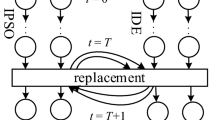Abstract
Node localization or positioning is essential for many position aware protocols in a wireless sensor network. The classical global poisoning system used for node localization is limited because of its high cost and its unavailability in the indoor environments. So, several localization algorithms have been proposed in the recent past to improve localization accuracy and to reduce implementation cost. One of the popular approaches of localization is to define localization as a least square localization (LSL) problem. During optimization of LSL problem, the performance of the classical Gauss–Newton method is limited because it can be trapped by local minima. By contrast, differential evolution (DE) algorithm has high localization accuracy because it has an ability to determine global optimal solution to the LSL problem. However, the convergence speed of the conventional DE algorithm is low as it uses fixed values of mutation factor and cross-over probability. Thus, in this paper, a self-adaptive mutation factor cross-over probability based differential evolution (SA-MCDE) algorithm is proposed for LSL problem to improve convergence speed. The SA-MCDE algorithm adaptively adjusts the mutation factor and cross-over probability in each generation to better explore and exploit the global optimal solution. Thus, improved localization accuracy with high convergence speed is expected from the SA-MCDE algorithm. The rigorous simulation results conducted for several localization algorithms declare that the propose SA-MCDE based localization has about (40–90) % more localization accuracy over the classical techniques.






Similar content being viewed by others
References
Harl H, Willig A (2005) Protocols and architectures for wireless sensor networks. Wiley, West Sussex
Akyildiz IF, Su W, Sankarasubramaniam Y, Cayirci E (2002) A survey on sensor networks. IEEE Commun Mag 40:102–114
Akyildiz IF, Su W, Sankarasubramaniam Y, Cayirci E (2002) Wireless sensor networks: a survey. Comput Netw 38:393–422
Chizari H, Poston T, Abd Razak S, Abdullah AH, Salleh S (2014) Local coverage measurement algorithm in GPS-free wireless sensor networks. Ad Hoc Netw 23:1–17
Aspnes J, Eren T, Goldenberg DK et al (2006) A theory of network localization. IEEE Trans Mob Comput 5:1663–1678
Wen F, Liang C (2015) Fine-grained indoor localization using single access point with multiple antennas. IEEE Sens J 15:1538–1544
Tarrío P, Bernardos AM, Casar JR (2012) An energy-efficient strategy for accurate distance estimation in wireless sensor networks. Sensors 12:15438–15466
Xiong H, Chen Z, Yang B, Ni R (2015) TDoA localization algorithm with compensation of clock offset for wireless sensor networks. China Commun 12:193–201
Liu Y, Hu YH, Pan Q (2012) Distributed, robust acoustic source localization in a wireless sensor network. IEEE Trans Signal Process 60:4350–4359
Maddumabandara A, Leung H, Liu M (2015) Experimental evaluation of indoor localization using wireless sensor networks. IEEE Sens J 15:5228–5237
Xu Y, Zhou J, Zhang P (2014) RSS-based source localization when path-loss model parameters are unknown. IEEE Commun Lett 18:1055–1058
Bulusu N, Heidemann J, Estrin D (2000) GPS-less low-cost outdoor localization for very small devices. IEEE Pers Commun 7:28–34
Niculescu D, Nath B (2003) DV based positioning in ad hoc networks. Telecommun Syst 22:267–280
Liu Y (2011) An adaptive multi-hop distance localization algorithm in WSN. Manuf Autom 33:161–163
Cheng BH, Vandenberghe L, Yao K (2009) Distributed algorithm for node localization in wireless ad-hoc networks. ACM Trans Sens Netw 6:8–20
Kulkarni R, Venayagamoorthy G, Cheng X, Maggie (2009) Bio-inspired node localization in wireless sensor networks. In: Proceedings of IEEE international conference on systems, man and cybernetics. https://doi.org/10.1109/ICSMC.2009.5346107
Arora S, Kaur R (2017) Nature inspired range based wireless sensor node localization algorithms. Int J Interact Multimed Artif Intell 4:7–17
Arora S, Singh S (2017) Node localization in wireless sensor networks using butterfly optimization algorithm. Arab J Sci Eng 42:3325–3335
Rajakumar R, Amudhavel J, Dhavachelvan P, Vengattaraman T (2017) GWO-LPWSN: grey wolf optimization algorithm for node localization problem in wireless sensor networks. J Comput Netw Commun. https://doi.org/10.1155/2017/7348141
Nagireddy V, Parwekar P, Mishra TK (2018) Velocity adaptation based PSO for localization in wireless sensor networks. Evol Intel. https://doi.org/10.1007/s12065-018-0170-4
Ni J, Li Z, Qi Y (2018) A gas source localization algorithm based on NLS initial optimization of particle filtering. Evol Intel. https://doi.org/10.1007/s12065-018-0191-z
Elbes M, Alzubi S, Kanan T (2019) A survey on particle swarm optimization with emphasis on engineering and network applications. Evol Intel. https://doi.org/10.1007/s12065-019-00210-z
Moravec J, Pošík P (2014) A comparative study: the effect of the perturbation vector type in the differential evolution algorithm on the accuracy of robot pose and heading estimation. Evol Intel 6:171–191
Harikrishnan R, Jawahar Senthil Kumar V, Sridevi P (2016) A comparative analysis of intelligent algorithms for localization in wireless sensor networks. Wirel Pers Commun 87:1057–1069
Annepu V, Rajesh A (2017) An efficient differential evalutionary algorithm based localization in wireless sensor networks. In: Proceedings of international conference on microelectronic devices, circuits and systems. https://doi.org/10.1109/ICMDCS.2017.8211560
Storn R, Price KV (1997) Differential evolution—a simple and efficient heuristic for global optimization over continuous spaces. J Glob Optim 11:341–359
Brest J, Greiner S, Boskovic B, Mernik M, Zumer V (2006) Self-adapting control parameters in differential evolution: a comparative study on numerical benchmark problems. IEEE Trans Evolut Comput 10:646–657
Qin AK, Huang VL, Suganthan PN (2009) Differential evolution algorithm with strategy adaptation for global numerical optimization. IEEE Trans Evolut Comput 13:398–417
Zhang J, Sanderson AC (2009) JADE: adaptive differential evolution with optional external archive. IEEE Trans Evolut Comput 13:945–958
Brest J, Maucec MS (2011) Self-adaptive differential evolution algorithm using population size reduction and three strategies. Soft Comput 15:2157–2174
Author information
Authors and Affiliations
Corresponding author
Additional information
Publisher's Note
Springer Nature remains neutral with regard to jurisdictional claims in published maps and institutional affiliations.
Rights and permissions
About this article
Cite this article
Annepu, V., Rajesh, A. Implementation of self adaptive mutation factor and cross-over probability based differential evolution algorithm for node localization in wireless sensor networks. Evol. Intel. 12, 469–478 (2019). https://doi.org/10.1007/s12065-019-00239-0
Received:
Revised:
Accepted:
Published:
Issue Date:
DOI: https://doi.org/10.1007/s12065-019-00239-0




